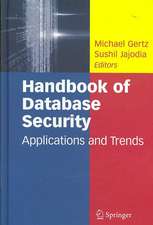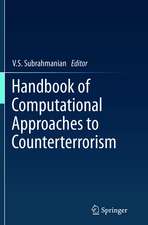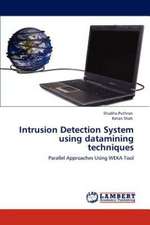Multimedia Database Systems: Issues and Research Directions: Artificial Intelligence
Editat de V.S. Subrahmanian, Sushil Jajodiaen Limba Engleză Paperback – 27 sep 2011
Din seria Artificial Intelligence
- 8%
 Preț: 218.19 lei
Preț: 218.19 lei -
 Preț: 78.18 lei
Preț: 78.18 lei - 20%
 Preț: 862.95 lei
Preț: 862.95 lei -
 Preț: 78.18 lei
Preț: 78.18 lei -
 Preț: 78.18 lei
Preț: 78.18 lei - 20%
 Preț: 855.98 lei
Preț: 855.98 lei - 20%
 Preț: 365.80 lei
Preț: 365.80 lei - 20%
 Preț: 641.01 lei
Preț: 641.01 lei - 20%
 Preț: 555.53 lei
Preț: 555.53 lei - 20%
 Preț: 324.64 lei
Preț: 324.64 lei - 20%
 Preț: 342.28 lei
Preț: 342.28 lei - 20%
 Preț: 330.24 lei
Preț: 330.24 lei - 20%
 Preț: 659.97 lei
Preț: 659.97 lei - 20%
 Preț: 331.58 lei
Preț: 331.58 lei - 20%
 Preț: 375.15 lei
Preț: 375.15 lei - 20%
 Preț: 661.47 lei
Preț: 661.47 lei - 20%
 Preț: 654.70 lei
Preț: 654.70 lei - 20%
 Preț: 1006.48 lei
Preț: 1006.48 lei - 15%
 Preț: 638.89 lei
Preț: 638.89 lei - 20%
 Preț: 1001.16 lei
Preț: 1001.16 lei - 20%
 Preț: 650.27 lei
Preț: 650.27 lei - 20%
 Preț: 330.42 lei
Preț: 330.42 lei - 20%
 Preț: 834.69 lei
Preț: 834.69 lei - 20%
 Preț: 326.46 lei
Preț: 326.46 lei - 20%
 Preț: 757.48 lei
Preț: 757.48 lei - 20%
 Preț: 642.19 lei
Preț: 642.19 lei - 20%
 Preț: 328.27 lei
Preț: 328.27 lei - 20%
 Preț: 339.99 lei
Preț: 339.99 lei - 20%
 Preț: 342.96 lei
Preț: 342.96 lei - 20%
 Preț: 648.44 lei
Preț: 648.44 lei - 20%
 Preț: 657.99 lei
Preț: 657.99 lei - 20%
 Preț: 654.55 lei
Preț: 654.55 lei - 20%
 Preț: 639.35 lei
Preț: 639.35 lei - 20%
 Preț: 656.03 lei
Preț: 656.03 lei - 20%
 Preț: 1000.50 lei
Preț: 1000.50 lei - 20%
 Preț: 338.81 lei
Preț: 338.81 lei - 20%
 Preț: 709.98 lei
Preț: 709.98 lei - 20%
 Preț: 652.73 lei
Preț: 652.73 lei - 20%
 Preț: 344.93 lei
Preț: 344.93 lei - 20%
 Preț: 653.06 lei
Preț: 653.06 lei -
 Preț: 394.29 lei
Preț: 394.29 lei
Preț: 647.79 lei
Preț vechi: 809.73 lei
-20% Nou
Puncte Express: 972
Preț estimativ în valută:
123.97€ • 134.61$ • 104.13£
123.97€ • 134.61$ • 104.13£
Carte tipărită la comandă
Livrare economică 22 aprilie-06 mai
Preluare comenzi: 021 569.72.76
Specificații
ISBN-13: 9783642646225
ISBN-10: 3642646220
Pagini: 344
Ilustrații: XVI, 323 p.
Dimensiuni: 155 x 235 x 18 mm
Greutate: 0.48 kg
Ediția:Softcover reprint of the original 1st ed. 1996
Editura: Springer Berlin, Heidelberg
Colecția Springer
Seria Artificial Intelligence
Locul publicării:Berlin, Heidelberg, Germany
ISBN-10: 3642646220
Pagini: 344
Ilustrații: XVI, 323 p.
Dimensiuni: 155 x 235 x 18 mm
Greutate: 0.48 kg
Ediția:Softcover reprint of the original 1st ed. 1996
Editura: Springer Berlin, Heidelberg
Colecția Springer
Seria Artificial Intelligence
Locul publicării:Berlin, Heidelberg, Germany
Public țintă
ResearchCuprins
Towards a Theory of Multimedia Database Systems.- 1. Introduction.- 2. Basic Ideas Underlying the Framework.- 3. Media Instances.- 4. Indexing Structures and a Query Language for Multimedia Systems.- 5. Multimedia Presentations.- 6. Related Work.- 7. Conclusions.- A Unified Approach to Data Modelling and Retrieval for a Class of Image Database Applications.- 1. Introduction.- 2. Approaches to Image Data Modeling.- 3. Requirements Analysis of Application Areas.- 4. Logical Representations.- 5. Motivations for the Proposed Data Model.- 6. An Overview of AIR Framework.- 7. Image Database Systems Based on AIR Model.- 8. Image Retrieval Applications Based on the Prototype Implementation of AIR Framework.- 9. Research Issues in AIR Framework.- 10. Conclusions and Future Direction.- A. Image Logical Structures.- The QBISM Medical Image DBMS.- 1. Introduction.- 2. The Medical Application.- 3. Logical Design.- 4. Physical Database Design.- 5. System Issues.- 6. Performance Experiments.- 7. Conclusions and Future Work.- Retrieval of Pictures Using Approximate Matching.- 1. Introduction.- 2. Picture Representation.- 3. User Interface.- 4. Computation of Similarity Values.- 5. Conclusion.- Ink as a First-Class Datatype in Multimedia Databases.- 1. Introduction.- 2. Ink as First-Class Data.- 3. Pictographic Naming.- 4. The ScriptSearch Algorithm.- 5. Searching Large Databases.- 6. Conclusions.- Indexing for Retrieval by Similarity.- 1. Introduction.- 2. Shape Matching.- 3. Word Matching.- 4. Discussion.- Filtering Distance Queries in Image Retrieval.- 1. Introduction.- 2. Spatial Access Methods and Image Retrieval.- 3. Snapshot.- 4. Filtering Metric Queries with Snapshot.- 5. Optimization of Spatial Queries.- 6. Conclusions and Future Work.- Stream-based Versus Structured Video Objects: Issues, Solutions, and Challenges.- 1. Introduction.- 2. Stream-based Presentation.- 3. Structured Presentation.- 4. Conclusion.- The Storage and Retrieval of Continuous Media Data.- 1. Introduction.- 2. Retrieving Continuous Media Data.- 3. Matrix-Based Allocation.- 4. Variable Disk Transfer Rates.- 5. Horizontal Partitioning.- 6. Vertical Partitioning.- 7. Related Work.- 8. Research Issues.- 9. Concluding Remarks.- Querying Multimedia Databases in SQL.- 1. Introduction.- 2. Automobile Multimedia Database Example.- 3. Logical Query Language.- 4. Querying Multimedia Databases in SQL.- 5. Expressing User Requests in SQL.- 6. Conclusions.- Multimedia Authoring Systems.- 1. Introduction.- 2. Underlying Technology.- 3. Sample Application - “Find-Movie”.- 4. Multimedia Toolbook 3.0.- 5. IconAuthor 6.0.- 6. Director 4.0.- 7. MAS’s and Current Technology.- 8. Conclusion.- Metadata for Building the Multimedia Patch Quilt.- 1. Introduction.- 2. Characterization of the Ontology.- 3. Construction and Design of Metadata.- 4. Association of Digital Media Data with Metadata.- 5. Conclusion.- Contributors.
Textul de pe ultima copertă
The emerging information superhighway will bring to homes and businesses the ability to access and manipulate a vast amount of information stored in a variety of forms in different databases. Multimedia systems facilitate the access and manipulation of such information across high-speed networks. Multimedia database systems are a new generation of database systems that will provide a unified and interactive framework for users to request and integrate information stored in a variety of media. Applications of such systems in scientific research, commercial and business activities (such as interactive TV systems for marketing, banking, entertainment, manufacturing, and design), law enforcement, and military operations are numerous and obvious. This book presents basic research establishing the theory and practice of multimedia databasae systems. Issues relating to the theory of such systems, query languages for multimedia databases, indexing structures, implementations of such systems, and industrial and government applications are addressed. The book will form a valuable text for advanced courses in Multimedia Database Systems.





















